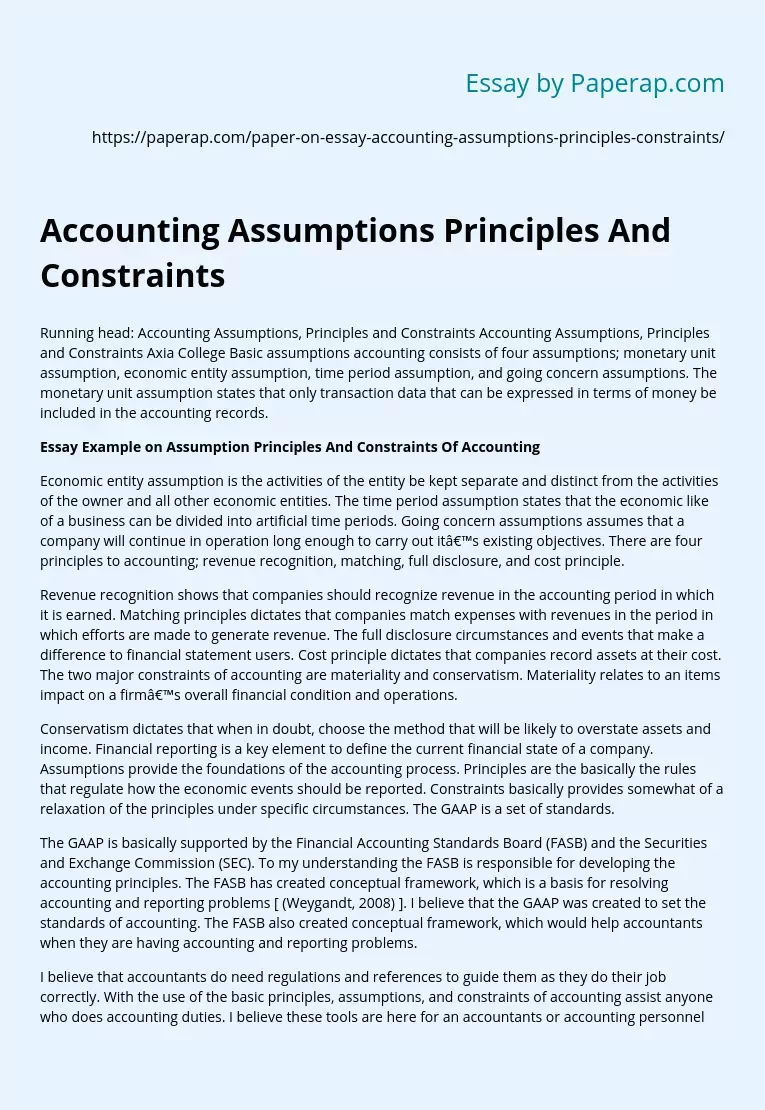Accounting Assumptions Principles And Constraints
Running head: Accounting Assumptions, Principles and Constraints Accounting Assumptions, Principles and Constraints Axia College Basic assumptions accounting consists of four assumptions; monetary unit assumption, economic entity assumption, time period assumption, and going concern assumptions. The monetary unit assumption states that only transaction data that can be expressed in terms of money be included in the accounting records.
Essay Example on Assumption Principles And Constraints Of Accounting
Economic entity assumption is the activities of the entity be kept separate and distinct from the activities of the owner and all other economic entities.
The time period assumption states that the economic like of a business can be divided into artificial time periods. Going concern assumptions assumes that a company will continue in operation long enough to carry out it’s existing objectives. There are four principles to accounting; revenue recognition, matching, full disclosure, and cost principle.
Revenue recognition shows that companies should recognize revenue in the accounting period in which it is earned.
Matching principles dictates that companies match expenses with revenues in the period in which efforts are made to generate revenue. The full disclosure circumstances and events that make a difference to financial statement users. Cost principle dictates that companies record assets at their cost. The two major constraints of accounting are materiality and conservatism. Materiality relates to an items impact on a firm’s overall financial condition and operations.
Conservatism dictates that when in doubt, choose the method that will be likely to overstate assets and income. Financial reporting is a key element to define the current financial state of a company.
Assumptions provide the foundations of the accounting process. Principles are the basically the rules that regulate how the economic events should be reported. Constraints basically provides somewhat of a relaxation of the principles under specific circumstances. The GAAP is a set of standards.
The GAAP is basically supported by the Financial Accounting Standards Board (FASB) and the Securities and Exchange Commission (SEC). To my understanding the FASB is responsible for developing the accounting principles. The FASB has created conceptual framework, which is a basis for resolving accounting and reporting problems [ (Weygandt, 2008) ]. I believe that the GAAP was created to set the standards of accounting. The FASB also created conceptual framework, which would help accountants when they are having accounting and reporting problems.
I believe that accountants do need regulations and references to guide them as they do their job correctly. With the use of the basic principles, assumptions, and constraints of accounting assist anyone who does accounting duties. I believe these tools are here for an accountants or accounting personnel can succeed and accomplish their mission. Works Cited Accounting Coach, L. (2004-2010). Accounting Coach. Retrieved 10 7, 2010, from Accounting Coach: http://www. accountingcoach. com/ Weygandt, J. K. (2008). Financial Accounting (6th edition). Hoboken, NJ: Wiley.
Accounting Assumptions Principles And Constraints. (2019, Nov 27). Retrieved from https://paperap.com/paper-on-essay-accounting-assumptions-principles-constraints/

